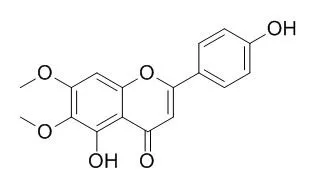| Description: |
Cirsimaritin has antibacterial, anti- inflammation, anti-tumor, antioxidant, renal protection and so on, it has potential use in patients with congestive heart failure, it can mitigate cardiac remodeling and left ventricular dysfunction through augmenting myocardial autophagy and decreasing matrix metalloproteinase-2&9 activities.
Cirsimaritin inhibits the growth of tumor cells and induced mitochondrial apoptosis in human gallbladder carcinoma cell line (GBC-SD), it triggers endoplasmic reticulum (ER) stress and down-regulates the phosphorylation of Akt. Cirsimaritin increases tyrosinase activity and melanin content in murine B16F10 melanoma cells by activation of CREB as well as upregulation of MITF and tyrosinase expression in a dose-dependent manner;support the putative application of cirsimaritin in ultraviolet photoprotection and hair coloration treatments. |
| Targets: |
Tyrosinase | cAMP | PKA | Akt | NADPH-oxidase | Calcium Channel | TNF-α | Antifection |
| In vitro: |
| Int J Mol Sci. 2015 Apr 20;16(4):8772-88. | | Melanogenesis-inducing effect of cirsimaritin through increases in microphthalmia-associated transcription factor and tyrosinase expression.[Pubmed: 25903150] | The melanin-inducing properties of Cirsimaritin were investigated in murine B16F10 cells. Cirsimaritin is an active flavone with methoxy groups, which is isolated from the branches of Lithocarpus dealbatus.
METHODS AND RESULTS:
Tyrosinase activity and melanin content in murine B16F10 melanoma cells were increased by Cirsimaritin in a dose-dependent manner. Western blot analysis revealed that tyrosinase, tyrosinase-related protein (TRP) 1, TRP2 protein levels were enhanced after treatment with Cirsimaritin for 48 h. Cirsimaritin also upregulated the expression of microphthalmia-associated transcription factor (MITF) after 24 h of treatment. Furthermore, Cirsimaritin induced phosphorylation of cyclic adenosine monophosphate (cAMP) response element-binding protein (CREB) in a dose-dependent manner after treatment for 15 min. The Cirsimaritin-mediated increase of tyrosinase activity was significantly attenuated by H89, a cAMP-dependent protein kinase A inhibitor. These findings indicate that Cirsimaritin stimulates melanogenesis in B16F10 cells by activation of CREB as well as upregulation of MITF and tyrosinase expression, which was activated by cAMP signaling. Finally, the melanogenic effect of Cirsimaritin was confirmed in human epidermal melanocytes.
CONCLUSIONS:
These results support the putative application of Cirsimaritin in ultraviolet photoprotection and hair coloration treatments. | | Cancer Lett. 2010 Sep 28;295(2):252-9. | | Reactive oxygen species-mediated endoplasmic reticulum stress and mitochondrial dysfunction contribute to cirsimaritin-induced apoptosis in human gallbladder carcinoma GBC-SD cells.[Pubmed: 20359814] | In this study, the anticancer effect of Cirsimaritin, a natural flavonoid, against human gallbladder carcinoma cell line GBC-SD and the underlying mechanisms were investigated.
METHODS AND RESULTS:
Cirsimaritin inhibited the growth of tumor cells and induced mitochondrial apoptosis in GBC-SD cells. In addition, Cirsimaritin triggered endoplasmic reticulum (ER) stress and down-regulated the phosphorylation of Akt, while knock-down of CHOP dramatically abrogated the inactivation of Akt and reversed the pro-apoptotic effect of Cirsimaritin.
Furthermore, Cirsimaritin provoked the generation of reactive oxygen species in GBC-SD cells, while the antioxidant N-acetyl cysteine almost completely blocked the activation of ER stress and apoptosis, suggesting Cirsimaritin-induced reactive oxygen species is an early event that triggers ER stress mitochondrial apoptotic pathways in GBC-SD cells. |
|
| In vivo: |
| Int .J. Clin. Exp. Pathol .,2016;9(2):509-20. | | Cirsimaritin ameliorates cardiac remodeling and dysfunction through promoting myocardial autophagy in rats with heart failure.[Reference: WebLink] | Cirsimaritin, a natural flavone, has been reported to exert various activities including antibacterial, anti-inflammation, anti-tumor, antioxidant, renal protection and so on. However, despite these pharmacological studies, whether Cirsimaritin alleviates heart failure is still unknown.
METHODS AND RESULTS:
Administration of isoproterenol led to a serious heart failure, as evidenced by the up-regulation of heart rate, weight index and end diastolic pressure of left ventricular, while by the down-regulation of left ventricular systolic pressure, maximal rate of pressure rise or decline of left ventricular. Pretreatment of Cirsimaritin significantly ameliorated these cardiac parameters in a dose-dependent manner. In addition, Cirsimaritin remarkably inhibited serum levels of Ang II, NE, TNF-α and BNP in rats with heart failure and attenuated the cardiac histological changes. Moreover, matrix metalloproteinase-2&9 activities were also suppressed by Cirsimaritin. Furthermore, myocardial autophagy was significantly promoted by Cirsimaritin in vivo and in vitro through inhibiting AKT1-RPS6KB1 signaling.
CONCLUSIONS:
These findings reveal that Cirsimaritin mitigates cardiac remodeling and left ventricular dysfunction through augmenting myocardial autophagy and decreasing matrix metalloproteinase-2&9 activities, suggesting its potential use in patients with congestive heart failure. |
|






 Cell. 2018 Jan 11;172(1-2):249-261.e12. doi: 10.1016/j.cell.2017.12.019.IF=36.216(2019)
Cell. 2018 Jan 11;172(1-2):249-261.e12. doi: 10.1016/j.cell.2017.12.019.IF=36.216(2019) Cell Metab. 2020 Mar 3;31(3):534-548.e5. doi: 10.1016/j.cmet.2020.01.002.IF=22.415(2019)
Cell Metab. 2020 Mar 3;31(3):534-548.e5. doi: 10.1016/j.cmet.2020.01.002.IF=22.415(2019) Mol Cell. 2017 Nov 16;68(4):673-685.e6. doi: 10.1016/j.molcel.2017.10.022.IF=14.548(2019)
Mol Cell. 2017 Nov 16;68(4):673-685.e6. doi: 10.1016/j.molcel.2017.10.022.IF=14.548(2019)